AP environmental science college board review
1/287
There's no tags or description
Looks like no tags are added yet.
Name | Mastery | Learn | Test | Matching | Spaced |
|---|
No study sessions yet.
288 Terms
Clean Water Act
It is a way to control point sources pollution and it requires industries of point sources to get a permit from the state and/or EPA before they can discharge any effluent (waste) into a body of water.
The point sources will also have to use effective technologies to treat the effluent (waste) before it can be discharged.
Nonpoint source pollution
is a category of water pollution and it is pollution that cannot be traced back to a single point or property… not from a single pipe.
Contributions of contaminants come from many sources accumulating over a wide area and eventually reaching a level that impairs water quality.
Examples of Nonpoint source pollution
Agricultural and residential areas can have excess chemicals such as: fertilizers, herbicides, insecticides
Water from rain, snowmelt, and irrigation running of parking lots, roads, lawns in urban/suburban areas can be a source of: oil, greases, and toxic chemicals.
Sediment, which is one of the most significant nonpoint sources pollutants in the United States, is soil particles made of sand, gravel, and clay, is from improperly managed: Construction sites, crop and forest lands, eroding stream banks.
How to manage nonpoint sources
________ ______ are not regulated through permitting but managed through programs that encourage partnerships between private landowners and business with local and states government working together.
Coral reefs
Are critical ecosystems in the oceans and cover less than 1% of the area but support 25% of marine species.
They are made up of animals that live symbiotically with algae that photosynthesize.
Bottom trawling
Is a destructive fishing practice to coral reefs and it is scraping nets along the ocean floor which breaks and crushes coral.
Marine debris
Is a destructive fishing practice to coral reefs and it is debris that it is left in the ocean like unattended nets, traps, and monofilament fishing line that can damage and injure reefs and reef-dependent organisms like young fish.
Overfishing
Is a destructive fishing practice to coral reefs and it is over removing fish, especially herbivores, which help maintain healthy algae populations in reef ecosystems.
Cyanide fishing
It is a destructive fishing practice to coral reefs and it is when sodium cyanide is poured over an area to stun fish so they are easier to catch for the aquarium and restaurant trade. This poisons corals.
Sedimentation threatens coral
Sedimentation, soil particles of rock, clay, and sand, can bury corals, blocking the sunlight needed by the symbiont so no photosynthesis can occur, which results in the death of the coral.
Optimal range of tolerance
Within this range reproduction, growth, and maintenance of homeostasis it at its best.
And this is a set of environmental condition a certain species is present in.
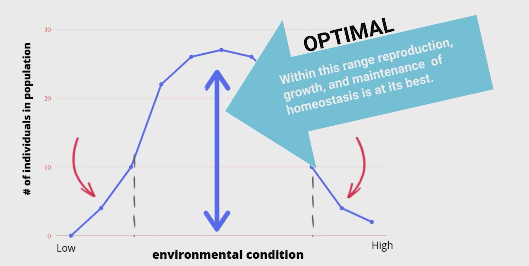
Zones of physiological stress
Are the low and high zones in the range of tolerance that inhibits the success of the organism.
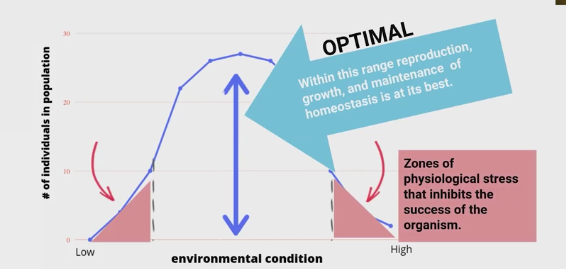
Coral bleaching
High temperatures causes a process called ______ _________ to occur in coral reefs.
This is where coral expels the symbiont out of its cells, resulting in a loss of food supply and the color from the chlorophyll pigment of the algae
Dissolved oxygen.
The amount of oxygen gas that is present in water. It’s essential for the survival or aquatic organisms, as they use dissolved oxygen to breathe. And the range of tolerance applied to ______ ______ (DO) for species living in aquif environments, furthermore DO is usually measured in ppm.
Though warm water does not hold as much dissolved oxygen as colder water as it is less dense and evaporates more.
Oxygen sag curve
is a plot of dissolved oxygen levels versus distance from a source of pollution with excess nutrients.
Pay attention to low oxygen tolerant species (can withstand low oxygen levels) and Low oxygen intolerant species (can’t stand low oxygen levels)
This first zone all the way to the left would be the clean zone where it is biologically diverse and there is low environmental impacts, evident in how there is high dissolved oxygen and the biological demand for oxygen is low.
Then for the next zone, which is decomposing, this is where there is a pollution event takes place, which pours nutrients into the water and causes algae bloom which either deplete the water of oxygen or when they are decomposed, the decomposers take in large amount of oxygen to decompose them. This leads to low dissolved oxygen context, and therefore a high biological demand, pared with low biological diversity.
The third zone, after the decomposing zone, would be the septic zone where there are still impacts of the pollution, evident in the low dissolved oxygen and high biological demand. Though in this area there is slight recovery.
After the septic zone, there would be the recovery zone where dissolved oxygen content is rising and the biological demand for oxygen is decreasing.
The last, zone, further away from a pollution site and after the recovery zone would be the clean zone again.
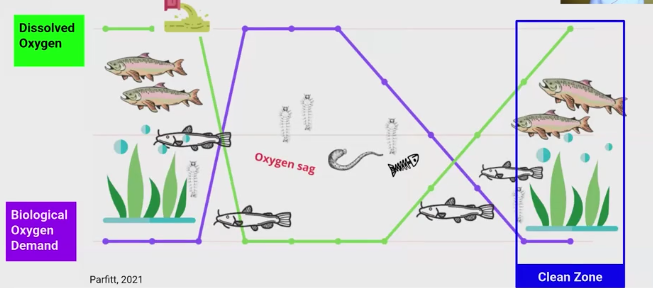
Oil spills impact wildlife
Oil that floats on the surface of the water can coat the feather of birds, robbing them of both insulation and the ability to fly.
The fur of marine mammal es like seals and sea otter can become saturated with oil, inhibition their waterproofing and ability to maintain their body temperature.
They can ingest the hydrocarbons as they try to groom the oil from their fur, and all organism that ingest or inhale hydrocarbons die from poisoning.
Some component of oil sinks to the ocean floor, and these oil blobs can stay at the bottom for a long time as they are not broken up by wave and wind action on the ocean surface. So organism living at the bottom are at risk of death through oil ingestion and submersion.
Coastal economies impact by oil spills.
Oil spills damage fishers for years as the growth and development of all fish species and the plankton that supports them is impacted.
With both the Exxon spill and the BP Deep water Horizon spill, oil that washed up on beaches impacted tourism, real estate, and fishing industries.
With the deep water Horizon spill losses in the billion of dollar was felt in Mississippi, Louisiana, Florida, and Alabama.
How producers and consumers are impacted by sedimentation
How producers and consumers are impacted by sedimentation:
Sediment suspended in the water column can affect primary producers (plants) because light infiltration is reduced. This impacts the ability of plants to photosynthesize and add oxygen to the water.
Predator that use vision as their primary sense for hunting are also impacted.
As the sediment settles, it can disrupt the eggs and large of aquatic species, like fish, insects, and mollusks.
Heavy metals that can be found in drinking water
Lead
Mercury
Arsenic
Copper
Cadmium
Chromium
How mining companies can release heavy metals into drinking water:
How mining companies can lease heavy metals into drinking water:
Mining companies often use acid to release metals from ore. This acid mine drainage can be a point sources pollution for surface water and groundwater.
Other industries, like smelting, chemical production, wastewater, and fossil fuel combustion can also release heavy metals into the environment.
Heavy metals in drinking water health cost
Heavy metals in drinking water health cost:
Heavy metals in drinking water can cause cancer, organ damage, and neurological issues.
Mercury cases neurological damage:
Mercury causes neurological damage:
Mercury poisoning is most often through eating fish or other aquatic organisms.
Mercury can be used in many industrial processes and end up in wastewater (used water that has been contaminated by household, industrial, or commercial use, and need treatment to remove pollutants before being released back into the environment). There it is converted by bacteria into, methylmercury, which is toxic and will bioaccumulate in organisms and biomagnify (toxic substance move up the food chain) in the food chain.
The impacts it has on health include:
Deteriorates nervous system
Impairs hearing, speech, vision and gait (the walking patterns in humans)
Cause involuntary muscle movements
Corrodes (to be gradually destroyed or weakened) skin and mucous membranes
Causin chewing and swallowing to become difficult.
Plastic waster threat to wildlife
Plastic waste threat to wildlife:
Plastic waste in waterways and he oceans has increased
ingestion of this litter has no nutritional value and can also block the digestive system, leading to painful starvation.
It can entalge the wildlife and lead to death by suffocation
Microplastic contribution to toxin
Microplastic contribution to toxin:
Microplastics, tiny degraded plastic particles and fibers can contribute toxins to the environment in two ways:
The releases of endocrine-disrupting chemicals like BPA added to plastic polymers when they are produced.
Chemicals like Pesticides cling to the tiny particles and are then ingested by plankton and other organisms.
Endocrine disruptors found in synthetic and natural chemicals
Endocrine disruptors found in synthetic and natural chemicals:
Endocrine disruptors can be synthetic chemicals used as:
industrial solvents/lubricants and their byproducts:
Polychlorinated biphenyls (PCBs)
Polybrominated biphenyls (PBBs)
dioxins
Plastics and Plasticizers
bisphenol A (BPA)
phthalates
Pesticides and fungicides
Pharmaceuticals
They can be found as natural chemicals in food:
Phytoestrogens found in soy
Some exposure can be from spill or leaching of improperly dispose of toxic waste. And some exposure are more persistent as the chemicals are in the soil, water, and air as well as material in our homes and workplaces.
Endocrine system
A network of glands that produce and releases hormones directly into the bloodstream to regulate various bodily functions.
And endocrine disruptors are any chemical that interferes with the production, transports, metabolism, or function of hormones in bodies.
Hormones are associated with homeostasis, reproduction, and development. Hormones you might recognize:
Estrogen
testerone
insulin
serotonin
norepinephrine
How endocrine disruptors impact cells
How endocrine disruption impact cells:
Endocrine disruption can mimic the structure of a signaling chemical that would normally bind with a cell receptor to trigger a cellular response.
Endocrine disruption can block the signal from reaching the receptor or block the transduction cascade.
Consequences include reproductive abnormalities, birth and developmental defects, or possible behavior changes.
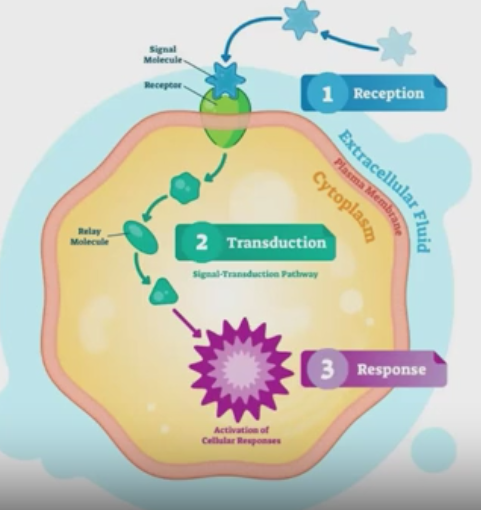
Endocrine disruption impact on aquatic systems
Endocrine disrupting chemicals enter waterways and bioaccumulate in organism and biomagnify in the food chains so that top-level consumers are most impacted.
People, predatory fish and amphibians that consume a high number of prey with endocrine disruption in their body will accumulate high elves of the chemicals.
This can cause eggs, not sperm present in the gonads of a male fish species.
In humans, low sperm counts have been recorded in communities with high pesticide use.
Developmental abnormalities in amphibians and fish in the wild have been recorded by investigators.
Wetlands
Are lands that are defined as having water covering the soil or is near the surface of the soil for all, or most of, the year.
Coastal (or tidal) _______ have fluctuating salinity and water levels as they are influenced by the tides.
Inland (or notidal) ___________ are along rivers and floodplains, in depression or low-lying areas near lakes and ponds and often have a seasonal nature to them.
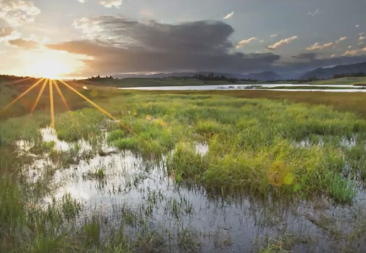
How wetlands improve water quality.
How wetlands improve water quality:
Water can move slowly in wetlands, giving sediment, nutrients, and pollutants time to drop out of suspension in the water column to the bottom of the wetland.
Excess nutrients from leaking septic systems (one site wastewater treatment systems), agricultural runoff, and municipal sewage, can be taken up by plant roots for use in growth or further broken down by microbes in wetland soils.
Pollutants can stick to soil particles or be taken up by plants.
Much of the sediment, nutrient, and pollutant load is reduced as water moves out of wetlands because of this filtering capacity.
How wetlands provide flood control
How wetlands provide flood control:
Wetlands act like sponges, holding water in place and releasing it slowly.
By slowing the movement of water, flood heights are reduced along with their erosive powers.
Coastal shorelines are protected and stabilized.
How wetlands maintain water flow during dry periods
How wetlands maintain water flow during dry periods:
Groundwater is recharged as water is held in wetland soils.
This also helps maintain surface water flows during dry seasons.
How wetlands increase biological productivity:
How wetlands increase biological productivity:
Wetlands are some of the most productive ecosystems on the planet because shallow water and plenty of plants allow for diverse habitat for animals and birds.
Nutrient-rich soils enhance plant growth which in turn provides food for diverse and abundant species.
Mangroves
_______ are a type of particularly productive and valuable type of coastal wetland.
They are dominated by ______ trees, which are salt-tolerant plants adapted to growing in saline or brackish water along coastlines.
In addition to living in a variety of saltwater conditions and providing shelter and food for a host of species, ______ can absorb four times the carbon dioxide that upland forests can.
Threats to wetlands
Development of commercial properties like restaurants, malls, airports, business offices, gas stations, etc. can all be damaging to wetlands.
Development can include filling in wetlands to build access roads, parking areas, or place utilities.
Construction can increase sedimentation, destroy habitat, and redirect water flow.
In the United States, development in wetlands is highly regulated through the Wetlands Protection and Restoration Act. Many states and tribal governments also have regulations for wetland protection.
Dam construction restricts and reduces water flowing into wetlands by disconnecting rivers from their floodplains and wetland areas.
The natural downstream flow of sediment that creates deltas and builds up estuaries along coasts is reduced.
Migration of fish and other species can be impacted.
Excess nutrients and pollutants from agriculture and industrial operation can impact wetlands, (example of CAFO/ concentrated animal feeding operation. These operation raise and house millions of animals)
Waste management is critical
Waste management is critical:
For example for a manure lagoon found at concentrated animal feeding operations (CAFOs) use heavy plastic lining and thick-walled embankment are to prevent leaked of nutrients and bacteria like e.coli.
Management of manure, as well as, other agricultural practices like Pesticides and insecticides use and soil management can help protect wetlands, surface and groundwater.
Eutrophication
Is when a waterway receive excess nutrients, this causes massive algae blooms plants and cyanobacteria, which once decomposed cause the oxygen to become depleted due to the amount of oxygen that is required for the massive amount of algae to be decomposed.
In lake Erie, toxic algae can threaten the drinking water for 11 million people in southwest Ohio and impact tourism, fishing, and recreation.
In most cases eutrophication is caused by the excess nutrient nitrogen from agriculture or urban runoff but also from phosphate in detergents.
Sources of cultural eutrophication
Sources of cultural eutrophication:
Excess fertilizers from farm fields
Sewage from wastewater treatment
Nitrogen from animal manure
Phosphate from detergents
These material are washed by rain, melting snow, and irrigation into streams, ponds, and lakes.
Eutrophic waterway
________ waterway is a water system that has high levels of algae as a result of excess nutrients.
It has high plant and algae populations though low dissolved oxygen.
This can happen due to things like a storm even washing fertilized into an aquatic system.
Aquatic organisms that can’t tolerate low oxygen levels will leave. If they can’t leave, they die. This adds more waste to be digested by oxygen-consuming microbes.
These conditions would create widespread hypoxia (condition where there is an insufficient amount of oxygen in the body’s tissue or organs) which would categorized the area as a dead zone.
Oligotrophic waterway
an __________ waterway has very low amounts of nutrients.
It has stable plant and algae population and high dissolved oxygen.
Thermal pollution
Is a rise or drop in the temperature of a natural body caused by human activities. This change in temperature can disrupt aquatic ecosystems by affecting the amount of dissolved oxygen impacting the tolerance of various species.
Sources of thermal pollution
When heated water is discharged into bodies of water, it is consider thermal pollution.
Power and industrial plants draw in water to cool machinery or products. They tend to discharge the heated water back into a water source.
Other sources include:
Soil erosion (when soil washes into a body, it makes the water murky, causing it to absorb more sunlight and heat up)
Deforestation/ shade reduction
Discharge from wastewater treatment
urban ruoff (carrying heated water from urban surfaces like roads and parking lots into waterways. This heated water lowers the dissolved oxygen in the water, harming aquatic life and ecosystems)
Impacts of thermal pollution
Slight variations in temperature can impact survival or eggs or leave of fish and aquatic insects that have narrow ranges of tolerance.
Die-offs can occur when dissolved oxygen levels are too low .
Feeding, breeding, and migration behaviors can also be altered.
Thermal refuge
This is aquatic species response to thermal pollution:
During winter months, when the ocean temperature can dip below 70 degrees, manatees seek out these warm water discharge areas as a place to feed and rest for the season.
Historically, manatees used natural springs to overwinter. These have disappeared due to development and agriculture pressures.
How is it that the lower dissolved oxygen levels aren’t an issue for the manatees (manatees are relatively tolerant due to their need to surface frequently to breathe).
Persistent organic pollutants
Are synthetic (not naturally occurring, it made by humans), carbon-based chemicals that persist in the environment for long periods, resist degradation, and accumulate in organism, potentially causing harm to both humans health and ecosystems.
They are often by-products of industrial process and can travel long distances through air and water systems (including wind and global patterns), impacting areas far from where they were released.
They are:
Persistent
Organic (because they are carbon-based)
Often in rings, with chlorine attached to the outside of ring (5-carbon ring)
Synthetic
Nopolar (don’t have a positive or negative end, meaning they don’t attract or repel water, so they are not soluble in water and tend to be more soluble in other nonpolar solvents)
fat-soluble
Example of Persistent organic pollutants
Dichloro-diphenyl-trichloroethane
Insecticide
Colorless crystal
Banned for use in the United States
Polychlorinated biphenyl (PCBs)
industrial fluid
yellow liquid
Banned for use in United States
And they were used to monitor or to reduce agricultural pests and also vectors for diseases—-everything from mosquitoes to lice—though it was banned due to the persistence aspect.
Though it is used in other countries to reduce diseases like malaria

Response to Persistent organic pollution in water and soil
Clear water Act was passed
Safe drinking water act was passed
RCRA —- Resource Conservation and Recovery act was passed
CERCLA —- Comprehensive environmental response, compensation and Liability act was based.
Stockholm Convention (international treaty that banned or reduce the manufacturer of these persistent organic pollutants)
Bioaccumulation
______________ is the selective absorption and concentration of elements or compounds by cells in a living organisms, most commonly fat-soluble compounds.
Biomagnification
The process where toxins and pollutants accumulate in organisms at higher trophic levels (e.g., predators) in a food chain, resulting in higher concentrations than in lower levels.
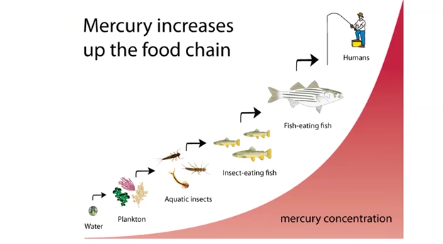
Substances that bioaccumulate
DDT (Dichloro-diphenyl-trichloroethane), which is a persistent organic pollutant.
Methylmercury (which is a heavy metal and is persistent)
PCB (Polychlorinated biphenyl), which is a persistent organic pollutant and endocrine disruptor.
Impacts of biomagnification on Apex predators
Impacts of biomagnification on Apex predators:
Secondary and tertiary consumers, like eagles, are impacted by the overuse of persistent organic pollutants, specifically DDT, when they reach a certain threshold concentration (from bioaccumulation), it inhibits the processing of calcium in the bodies of apex predators.
Eggshells are made, among other things, of calcium, so when these birds do lay their eggs, the’re very thin. So what happens when these eggshell are laid is either, when they hit the nest, they will break open. Or the active brooding, keeping that egg warm, will end up crushing the egg.
This will have the impact of lowering the population due to the fact that there eggs are not viable enough to be carried into full term growth.
Pollutant can also cause deformity in the chicks themselves, which decreases the chance of survival for the chicks chicks
Ozone layer
The ______ layer is a region in Earth’s stratosphere that contains a high concentration of ______ (O3), which acts as a shield against harmful ultraviolet (UV) radiation from the sun, and it is naturally occurring and approximately 15 to 35 kilometer above the Earth’s surface.
This layer is essential for protecting life on Earth by absorbing most of the sun’s UV-B and UVC radiation.
Though the ______ (03) from photochemical smog; is located in the troposphere and is not naturally occurring as it is formed from greenhouse gases/ greenhouse effect.
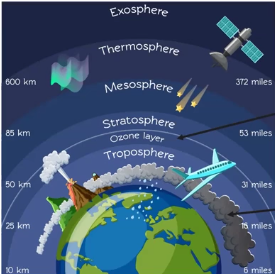
Different types of ultraviolet radiation from the sun.
Different types of ultraviolet radiation from the sun:
UV-C: is the strongest and most energetic type of ultraviolet radiation and is comes in about 180 to 280 nanometers. And 100% of it is absorbed by the ozone layer.
UV-B: Is the second strongest ultraviolet radiation and it comes in between 280 and 315 nanometers. And 95% of it is absorbed by the ozone layer.
UV-A: is the weakest type of ultraviolet radiation and it comes in about 215 and 400 nanometers. And 5% of it is absorbed by the ozone layer.
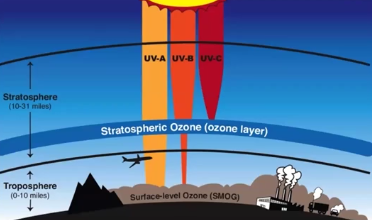
How UV-C is blocked by the ozone layer
Once UV light that is below 240 nm comes in contact with the ozone layer, where UV-C comes in about 180-280 nanometers, it will disrupt the bond of the oxygen molecule present in the ozone layer, which will cause it to break and form 2 oxygen atoms.
These oxygen atoms (0) will quickly attach to natural oxygen (02) to form ozone (03)
Peak ozone (03) generation occurs at 185 nm wavelength of UV light.
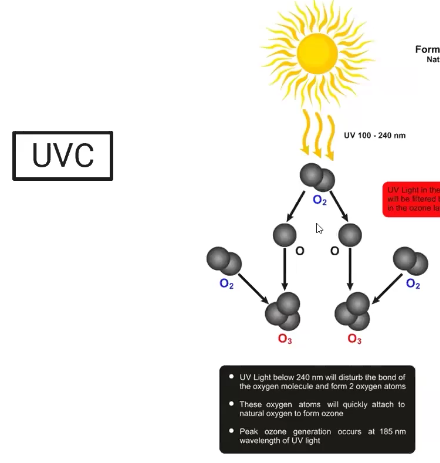
How UV-B is blocked by the ozone layer
Once UV light that is between 240-315 nm comes in contact with the ozone layer, where UV-B comes in between 280 to 315 nanometers, it will disrupt the bond of the ozone molecule (O3) and convert this ozone back into oxygen (02). Which leaves one oxygen atom present (0)
The oxygen atom present (0) will find another sing oxygen atom (0) to form another oxygen molecule (02)
Peak ozone destruction occurs at 254 NM wavelength of UV light.
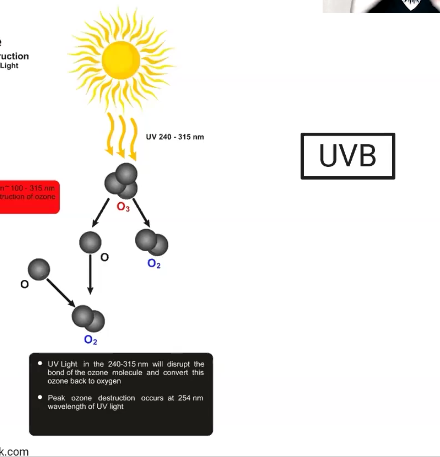
How the antarctic impacts the ozone layer:
how the antarctic impacts the ozone layer:
Antarctic winters can create stratospheric clouds full of ice crystals (so clouds that rise to the stratosphere and are full of ice crystals)
The ice crystals melt in the beginning of the spring (which happens in September and October since it is in the southern hemisphere)
Chemical reactions happening in the stratosphere convert the less reactive chlorine, from the ice crystals, to a more reactive form.
The more reactive form of chlorine degrades ozone into atmospheric oxygen (o2)
This causes the ozone layer to thin.
Chlorofluorocarbons (CFCs)
Is a chemical that was developed as a refrigerant/coolant, so it cools refrigerators.
It was also used as a propellant, so a substance that provides the force needed to move something else forward.
And lastly, it was used in some types of plastics.
It was a stable compound, meaning it doesn’t easily break down or react in the environment, and it is an inert gas, meaning it is a gas that doesn't readily react with other substance under normal conditions. Furthermore, if it does escape it will rise into the troposphere and eventually the stratosphere, as it also contribute to the greenhouse effect.
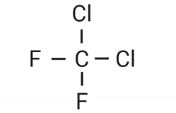
Chlorofluorocarbon impact on the stratosphere
When CFCs become present in the ozone layer in the stratosphere the chlorine atom (Cl) of the CFCs atom is disconnected with the CFCs molecule as it is pulled to an ozone molecule (o3)
Then the chlorine atom (Cl) binds with the ozone molecule (O3) to form ClO which pushes out an oxygen molecule (O2).
Then ClO will go to bind with an oxygen atom (0) where it will have the byproducts of becoming a single chlorine atom (Cl), and the oxygen atom from the previous ClO, will bind with the oxygen atom to become an oxygen molecule (o2).
Then the single chlorine (Cl), will repeat the whole process by starting with combing with an ozone molecule (O3)
This break down of ozone from this process into an oxygen molecule has the impact of thinking the ozone layer.
The thinning of the ozone layer will have the impact of allowing more UV-C and UV-B to pass through this layer and reach the ground of earth.
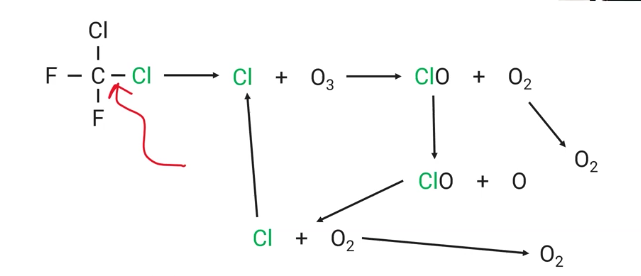
Effect of ozone depletion
The impact of ozone depletion (where there is thinning of ozone layers, especially at poles), has the impact of disruption of terrestrial photosynthesis. This occurs cause the increased UV-B radiation can damage plant tissues, affecting leaf structure and reducing the ability of plants to effectively perform photosynthesis, and it can damage their cells. This hinders photosynthesis.
It can also cause disruption of photosynthesis by phytoplankton by the increased UV radiation damaging their DNA and cellular structures, ultimately reducing their growth and productivity.
The impact this has on the producers can cause a disruption of food chains. webs.
Furthermore it impacts populations of some organism like amphibians because amphibians lay their eggs in water so they don’t have any shells on them so that UV light can directly interact with the egg. So the increased UV causes mutations in the eggs that prevent the egg from hatching, or surviving to adulthood.
In humans the increased exposure to UV can cause mutation in the skin that can cause skin cancer. Furthermore cataracts, which are a clouding of the lens of the eye (which is typically clear, can be a product of excessive exposure to UV light. This can lead to blurring or complete blindness that is irreversible.
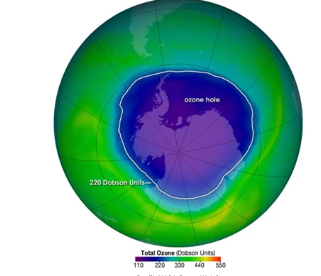
Montreal Protocol
Was an International treaties that arose when two chemist found the impacts of CFCs in the thinning of the ozone layer.
This international treaty led everybody to agree that CFCs were thinning the ozone layer and it is a prevailing problem that needs to be prevented to help combat skin cancer and cataracts in humans.
So in this treaty started to phase out the use of chlorofluorocarbons and also their manufacture, which was done in 1987, though the United States started phasing these out in 1994.
Though because CFCs are stable it is going to take a long time for them to phase back decades for the ozone layer to be fully repaired.

HFCs replace CFs.
Due to the Montel protecall, which banned the use of CFCs, they have been replaced with hydrofluorocarbons (HFCs) which is a molecule that doesn't contain chlorine, and preformed that same functions as CFCs.
Though the drawbacks is they are a greenhouse gas and they contribute to the greenhouse gas effect, and these HFC’s include:
Fluoroform (HFC-23)
Difluoromethane (HFC-32)
Fluoromethane (HFC-41)

The greenhouse effect
This takes place in the troposphere, which is the closest atmospheric level to the ground and where we have most of our weather.
First solar radiation that has passed the ozone layer, some of it is absorbed by terrestrial soil, bodies of water, and some of It is reflected back up into the atmosphere.
Though after it has been absorbed by the Earth's ground some of it is radiated back into the atmosphere as infrared radiation, or heat.
Some of that reflected infrared radiation is absorbed by greenhouse gases, and turned into longer infrared radiation, which is radiated back into the atmosphere and back down to earth (This is called the __________ effect, which is the naturally warming of the earth).
Key Note: 78% of the atmosphere is made of nitrogen, 21% of it is oxygen, and in that remaining 1% a fraction of that 1% are the presence of greenhouse gases that make life possible on this planet.
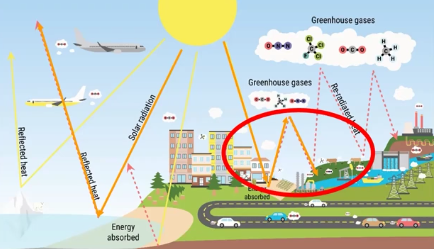
Greenhouse gases
These gases include:
Carbon dioxide — CO2 —- these are naturally occurring but can be emphasized by human activities
Methane — CH4 —— these are naturally occurring but can be emphasized by human activities
Water Vapor — H20 —- these are naturally occurring but can be emphasized by human activities
Nitrous oxide — N20 —- these are naturally occurring but can be emphasized by human activities
Chlorofluorocarbons (CFCs) — CF2CL2 — these are human made
Hydrofluorocarbons (HFCs) — these are human made
Tropospheric ozone — O3 — these are human made.
Sources of Greenhouse gases from humans
Sources of Greenhouses gases from humans:
For Carbon dioxide:
Transportation 34%
Electricity 32%
Industry 15%
Residential & Commercial 11%
Other (Non-fossil fuel combustion) 7&
For Methane:
Enteric Fermentation (where microbes in the digestive tract of ruminate animals, like cattle and sheep, break down food and produce methane as a byproduct)
Natural Gas and Petroleum systems 28%
Landfills 17% (when organic waste decomposes under anaerobic conditions/without oxygen this release methane)
Manure Management 10% (anaerobic condition in manure storage allow bacteria to produce methane as a byproduct)
Coal Mining 8%
other 9%
For Nitrous Oxide:
Agriculture and soil management 78% (can be emitted through synthetic fertilizers)
For Fluorinated Gas (CFCs and HFCs)
Substitution of ozone depleting substances like coolants
For Tropospheric ozone (03)
This is present in troposphere and it is a secondary pollutant that is formed as a part of the chemical reactions that from photochemical smog in the troposphere.
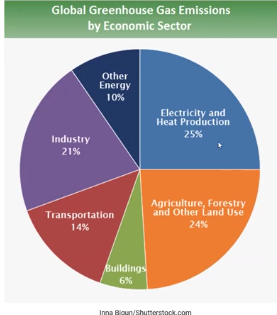
Water vapor as a greenhouse gas
Water vapor, which is naturally occurring, becomes present in the atmosphere through evaporation. And the time that it builds up in the atmosphere is not signification was it condense, and forms precipitation.
Due to this its resident times, which is the time that water vapor is present in the troposphere, is relatively short. Which reinforce the idea that water vapor is not an impactful greenhouse gas.
Global warming potentials
A greenhouse ______ _______ ______ is based on the amount of energy that it re-radiates and it residence time in the atmosphere.
Carbon dioxide is used as the standard to be compared to other greenhouse gases because it has a ______ ______ _____ of 1.
Though water vapor is not considered on this because its resident time in the atmosphere is so low.

Concentration of greenhouse gases.
Concentration of greenhouse gases in the atmosphere is a key factor to look at in determining what greenhouses gas needs to be combated. And the most concentrated greenhouses gas in the atmosphere would be Carbon dioxide, which has about 81% concentration, despite its GWP of 1.

The greenhouse effect amplifies
Due to the increase of the greenhouses gases present in the troposphere it has caused the greenhouse effect to amplife, meaning there is more heat that is being re-radiated back into earth due to the growing abundance of greenhouses gases.
This has the impact of rising the global temperatures over time. (climate change)

Sea levels rise
Is an impact of climate change and this is where land ice (ex— continental glaciers, ice sheets) melts, adding to the volume of water in the ocean.
Due to ice having a high albedo, which is refleacity of UV, it reflects a lot of the sun’s radiation which provides cooling effects. Though as more land is exposed as the ice melts, more UV is absorbed which releases heats, due to land having a lower albedo, so it reflects less of the Sun’s radiation.
Thermal expansion of the ocean happens, due to warming from climate change, which increase the volume of the ocean, due to the fact that as water heats up it expands.
This has the impact of increasing flooding, hurricanes, and typhoons. (due to warmer water providing more energy for these storms to develop and intensify) And increasing the marine environment.

Diseas vectors expand their range
Disease vectors, like mosquitoes and ticks, are able to expand their living range as the Earth's climates increase in warmth. This occurrs because more places fit their ecological niches, for a warm environment (as they becomes warmer due to climate change), which allows them to expanded to new places that can now support their survival.
This can have an impact of spreading of disease to new places, that are carried by these diseases vectors.

How climate change impacts populations
How climate change impacts populations:
Habitat destruction (like saltwater intrusion of inland wetlands)
Loss of food source (organism die out due to increase temperatures)
Timing of food source availability changes (vegetation will sprout early due to the early coming of spring, marked by warmer temperatures, though delys will happen as migration patterns of animals like birds stay the same)
New salinity beyond range of tolerance (can cause things like the calcium carbonate of organisms to dissolve)
Increased storm intensity (warm water feeds the intensity of storms like typhoons and hurricanes)
Increased possibility of fire (more arid conditions due to increased evaporation)
Impacted annual group behaviors; timing of migration, hibernation.
How climate change impacts human populations.
Exposure impacts on humans populations due to climate change:
Extreme heat
Poor air quality (increasing temperatures, lead to more ozone formation, which is a major component of smog, and increased wildfire activity)
Reduced food and water quality (by altering environmental conditions, like changes in perception and temperatures, which can damage crops)
Changes in infectious agents
population displacement
Health outcomes due to exposure impacts from climate change:
Heat-related illness
Cardiopulmonary illness (by worsening air pollution and extreme temperatures causing impacts on both the heart and lungs)
Food-water-and vector borne disease
mental health consequences and stress
Populations that are more vulnerable to impacts of climate change:
Populations that are more vulnerable to impacts of climate change:
Low-income populations (they have fewer resources to cope with and adapt to climate-related hazards. They may live in areas that lack access to essential services like clean water and healthcare, and rely on resources that are affected by climate change)
Occupational groups (due to increased exposure to extreme weather events and hazers, particularly those working outdoors or in high-risk areas)
People in certain locations
Pregnant women
People with pre-existing medical conditions
children
older adults
people with disabilities
indigenous people (because they often rely heavily on natural resources for their livelihoods and well-being, and are frequently marginalized and lack access to essential resources and infrastructure)
Ice Historical records of climate change
There is data for about the past 800,000 years up till present that tells us about regular periods of warming and cooling, and regular periods of carbon dioxide increases and decreases in concentration in our atmosphere.
One way we get this information from is ice cores, where you drill down into the ice and pull out a long cylinder of ice and use that to get data.
As there are air bubbles present, which can be extracted and measured by how much carbon dioxide is there. And the darker lines tell about different melting times, which gives evidence on warming and cooling.

Volcanic records for climate change.
We can pull data from volcano ash which tells us the max and min values of the warming and cooling, and different concentration in the atmosphere.
It can also display how gradually those changes happens over periods of time

Changes in air circulation from climate change:
Changes in air circulation from climate change:
Convection currents, like the Hadley cells, could change in size which would cause disruptions in the movements of of warm, cool, wet, and dry winds as the perception and temperature are impacted.
This will have the impact of altering the climates of biomes.
The jet stream, which is one of the air patterns visible around the globe, could also change in speed and strength which would lead to changes in the type and intensity of local and global weather patterns.

Climate change impact on soil variability and erosion
Climate change impact on soil variability and erosion:
The increased temperatures would have the impact of drying out the soil which would lessen its effectiveness on holding soil in place, causing more soil erosion to happen through wind.
The increased water levels and storm intensity would have the impact of increased soil erosion through water.
Climate change impact of permafrost
As the globe is getting warmer the permafrost is melting, which is making the undecayed organic matter below the permafrost wet.
This leads to anaerobic decomposition of the organic matter, which is producing methane. Which is a greenhouse gases that has the impact of making the earth warmer, which further increase the impacts of the defrosting of permafrost, demonstrating that positive feedback loop.

Climate Change impact of Sea ice in the arctic.
Sea ice is a part of a polar bears natural habitat, as they use the sea ice to go out to where seals will create breathing holes so they can hunt them.
If the sea ice melts, it means that the polar bears no longer have a calorically efficient way of getting to those seals. And other hunting practices, like swimming, are not calorically efficient due to the fact that they require a lot of calories to execute, especially with the fact that seals are good swimmers.
This reduced the access they have to food and ultimately its a habit problem to.
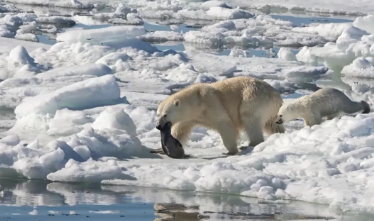
Climate change impact on Coral reefs
Climate Change impact on Coral reefs:
As the sea levels rise it causes less UV radiation to reach coral reefs, so they are prohibited from performing photosynthesis, because the increase water levels have the map of filtering out the UV light.
This influence the death of coral reefs as they temperature range is out of their range of tolerance (becoming hotter), and there is not sufficient sunlight to help them perform photosynthesis, so they ultimately die out. (coral bleaching; where the increase water temperatures can stress coral, causing them to expel their algae.)
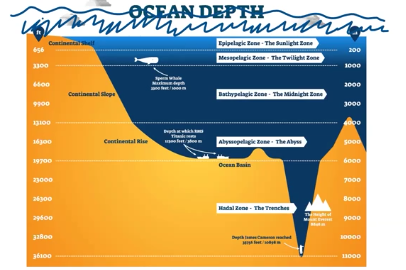
Climate change impact of ocean currents:
Climate change impact of ocean currents:
Density changes in ocean current are impacted do to the melting of cool, freshwater from the glaciers and the warming of the ocean by increasing temperatures.
This impacts the direction of heat and cold through ocean currents.
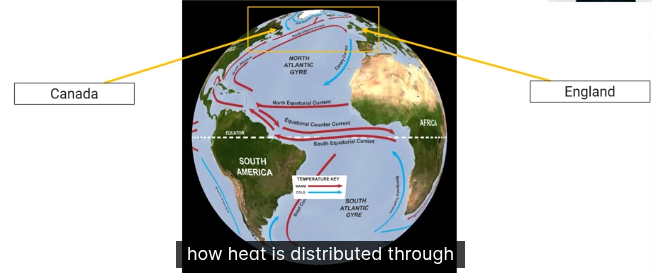
Ocean warming
Is the global increase in ocean water temperatures. Though the amount of warming isn’t uniform across the globe—-some ocean areas have warmed more quickly than others.
This is caused by increased greenhouse gases in Earth’s atmosphere, such as carbon dioxide and methane.—-the IPCC estimates that our oceans have absorbed 93% of the excess heat from greenhouse gas emissions since the 1970’s.
In the graph that line would be the average (0.0^C & 0.0^F)
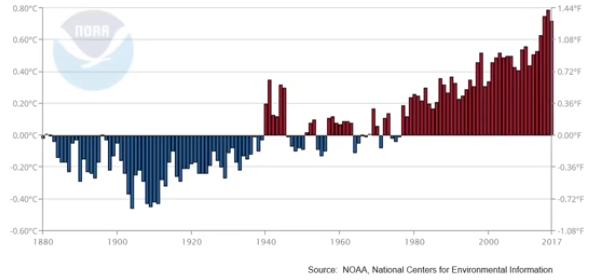
Ocean warming effects on habitat
Ocean warming affects marine species habitats in ways that includes:
Reduction of sea ice negatively impacts hunting/feeding patterns
Higher water temperature impact predator/prey interactions, as prey migrate to cooler areas.
Sea level rise alters coastlines, impacting species that use both land and water resources.
Rising Coastal seas may push some communities out of the photic zone
Warming oceans may impact primary productivity of phytoplankton, which are the basis of marine food webs.
Ocean warming metabolic changes
Ocean warming metabolic (is a chemical process within an organism that convert food into energy) changes:
As the ocean warms, marine species may migrate, but they cannot locally escape to cooler areas —- they are always surrounded by the warmer water
Organism are pushed to their biological thermal limits and become weakened or die
Reduction of biodiversity disruptions the trophic structures.
Ocean warming reproductive changes
Ocean warming reproductive changes:
Organism weakened by thermal stress of not reproduce well
Many marine reproductive patterns (mating times, egg hatching times, larval developments) are timed based on specific ocean temperatures—disruptions of these temperature patterns leads to reproductive harm.
Coral Bleaching
Is an ocean warming effect on coral reefs:
Corals have algae that live within their bodies in mutualistic relationships beside helping provide food for the coral,these algae also give coral their unique colors.
Warming ocean temperatures stress the corals, and when stressed, corals expel their symbiotic algae, which give them a “beached” appearance.
Corals can recover from a bleaching event, but if the conditions that caused the bleaching continue, this will often lead to the death of the coral.
Ocean acidification
It is the decrease in pH of ocean waters, and it is due primarily to increased greenhouse gas concentration in the atmosphere, specifically carbon dioxide, CO2.
The more CO2 is released into the atmosphere, the more the oceans absorb it, lowering their pH through specific chemical reactions.
In the approximately 200 years since the beginning of the induction revolution, the pH of the ocean has fallen by 0.1 pH units, from a pre-1800’s level of 8.2 to today’s measures of 8.1.
The pH scale is logarithmic— each jump of 1 on the scale represents a ten-fold changes in the concentration of hydrogen (h+) ions— so this drop actually represents about a 30% increase in acidity.

Chemical reaction that causes the ocean to acidify.
Chemical reaction that causes the ocean to acidify:
When CO2 is absorbed by seawater, a series of chemical reactions occurs which results in an increase in hydrogen ions.
The water combines with the carbon dioxide to create carbonic acid, which is a weak acid. (H2C03)
The carbonic acid than dissociates into hydrogen ions (H+) and bicarbonate ions (HC03-)

Ocean Acidification effects marine shells
Ocean acidification effects on marine shells:
The shells of many ocean creatures and the skeletons of corals are made of calcium carbonate, CaCO3
To make CaCo3 for their shells, marine organism combine calcium ions, (Ca+2) and Carbone's ions, (CO3-2)
With acidification, the increased concentration of hydrogen ions (H+) from the dissociation of carbonic acid bond with available Carbone's ions (CO3-2) in sweater (hydrogen ions bond more readily with Carbone's ions and calcium ions do)
When hydrogen ions bond with Carbon ions, a bicarbonate ion, HCO3- is formed.
Unfortunately, marine organisms can’t extract the carbonate they need from this bicarbonate ion, making it harder for them to build shells and exoskeletons.
If there are enough free H+ ions around, they can even break apart existing CaCO3 bonds, dissolving shells and Skelton's that are already formed.

Ocean Acidification impact on Coral reefs:
Ocean Acidification impact on Coral reefs
Ocean acidification is harmful to cereal because corals need free Carbone ions to form their Skeletons.
Corals are the foundation of highly biodiverse reef ecosystems, and provide food and habitat for a variety of marine life. When corals are damaged or die off, ocean biodiversity is severely impacted.
Combined threats from ocean acidification and ocean warming mean coral reefs are particularly vulnerable to effects to climate change.
HIPPCO
________ is a useful acronym that helps you remember the main factors leading to decreases in biodiversity:
H— Habitat destruction
I—- Invasive species
P——-Population growth (Human)
P——-Pollution
C——-Climate change
O—-Over exploitation
Habitat Fragmention
______ __________ occur when large habitats are broken up into smaller, isolated areas.
-Causes of _____ _______ include:
Construction of roads and pipelines
Clearing of land for agriculture or development
Logging
Though some species may actually benefit from increased fragmentation, such species that thrive in edge habitats.
Habitat Fragmention impacts
Not all species are equally impacted by the adverse effects of habitat fragmentation
Generalist who can thrive in a range of abiotic conditions, or species that thrive in, “edge” habitats may actually increase in number when an intact habitat becomes fragmented, and can tolerate much greater fragmentation than specialists.
Specialist species who have specific habitats requirements, as well has migratory and territorial organism, are usually adversely affected by habitat fragmentation.
Fragmentation generally, decrease overall ecosystem biodiversity even it if increase the relative numbers of ceraint species.
Climate Change and Habitat Loss
Climate Change and Habitat Loss:
As average global temperatures rise, habitats may be lost due to:
Coastal inundation (flooding) from melting land ice, and permafrost
Rising sea levels due to thermal expansion
Changes in precipitation patterns due to changing atmospheric and oceanic circulation patterns.
Climate change has been more instead in northern latitudes; as warming trends continue, these areas will be at more risk for habitat loss and loss of biodiversity.
Domestication
________ involves artificial selection, in which organisms with the most desirable traits for humans are crossbred to enhance the occurrence of that in the species.
Many ______ species are managed for economic returns, and provide humans with: Food, labor, medicine, pollination services.
How Domestication causes Loss of Biodiversity
How Domestication causes Loss of Biodiversity:
When humans assume responsibility for the reproduction and selection of traits in another species, genetic diversity will be reduced.
Genetic diversity is one facet of biodiversity, so domestion for economic returns leads to loss of biodiversity.
Examples of this can been seen in domestic livestock (cattle, sheep, goats, pigs), honeybees, and the agricultural practice of monocropping.
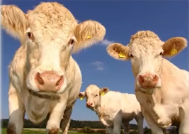
Strategies to Mitigate Biodiversity Loss
Strategies to Mitigate Biodiversity Loss:
Some strategies to help with this include:
The creation of protected areas, such as wildlife refuges and parks
The creation of habitat corridors (a strip of land that connected two or more habits patches, slowing animal and plants to move between them safely) to reduce the negative effects of habitat fragmentation.
Restoration of lost habitats
Sustainable land use practices. (include sustainable agriculture and forestry)
Factors that may lead to Extinction
As habitats are lost or altered globally, many species are threatened with extinction.
Certain factors may make a species more likely to become extinct, and some of these include:
Being extensively hunted
Having a limited diet
Being outcompeted by invasive species
Having specific, limited habits requirements.
Hunting causing extinction
Extensive hunting can lead to the loss of species.
For example, poaching is illegal hunting, killing or capturing animals for sale or profit. Animals may be hunted for:
Food
Prized body parts
Traditional medicinals uses
Medical research purpose
sport
Limited Diet and Habitat causing extinction
Limited Diet and Habitat causing extinction:
Species who are niche specialist are generally at greater risk of extinction.
Organism with specialist traits, such as:
Specific habitats requirems
Limited diet
Low reproduce rate/ long gestation times
Few offspring with high parental care
….may fare poorly under altered conditions.
Especially as global change intensifies, ecosystems are at risk and specialist species may be less able to adapt to rapid environmental changes.